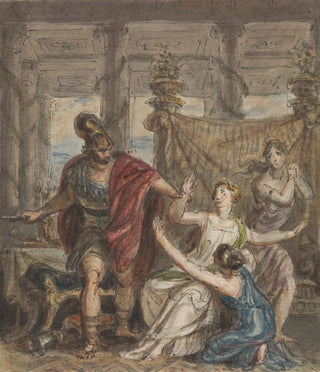Art print | Study of a soldier attacking a woman - Robert Smirke


View from behind

Frame (optional)
Reproduction of "Study of a Soldier Attacking a Woman" by Robert Smirke – Captivating Introduction
The artwork "Study of a Soldier Attacking a Woman" by Robert Smirke is a striking piece that evokes complex emotions and a profound reflection on human nature. This dramatic representation, both brutal and poignant, depicts a scene of conflict that transcends mere art to address universal themes such as violence, vulnerability, and the struggle for survival. Immersed in this universe, the viewer is invited to contemplate the moral implications of the depicted act, while being captivated by the artist's technical mastery. The dynamic between the characters and the palpable tension of the scene are elements that make this work a powerful testament to narrative art of the early 19th century.
Style and uniqueness of the work
Smirke's style is distinguished by its striking realism and ability to capture moments of intense tension. In "Study of a Soldier Attacking a Woman," every detail is carefully crafted, from facial expressions to the postures of the characters. The artist employs a palette of dark colors that enhances the heavy atmosphere of the scene, while playing with contrasts to highlight the struggle between the aggressor and the victim. The composition, though dynamic, is also balanced, guiding the viewer's gaze through the different layers of the work. Smirke manages to create a visual narration that is both thought-provoking and shocking, offering a reflection on the consequences of war and violence on the individual.
The artist and his influence
Robert Smirke, born in 1752, is an emblematic figure of British neoclassicism. Trained at the Royal Academy, he established himself as a renowned artist, influencing many contemporaries with his unique vision. His work, marked by a commitment to social and political subjects, reflects the tumult of his era, notably the Napoleonic wars. Smirke does not merely reproduce battle scenes but seeks to convey deep emotions and engage the viewer in a reflection on the human condition. His legacy endures through generations of artists.

Matte finish

View from behind

Frame (optional)
Reproduction of "Study of a Soldier Attacking a Woman" by Robert Smirke – Captivating Introduction
The artwork "Study of a Soldier Attacking a Woman" by Robert Smirke is a striking piece that evokes complex emotions and a profound reflection on human nature. This dramatic representation, both brutal and poignant, depicts a scene of conflict that transcends mere art to address universal themes such as violence, vulnerability, and the struggle for survival. Immersed in this universe, the viewer is invited to contemplate the moral implications of the depicted act, while being captivated by the artist's technical mastery. The dynamic between the characters and the palpable tension of the scene are elements that make this work a powerful testament to narrative art of the early 19th century.
Style and uniqueness of the work
Smirke's style is distinguished by its striking realism and ability to capture moments of intense tension. In "Study of a Soldier Attacking a Woman," every detail is carefully crafted, from facial expressions to the postures of the characters. The artist employs a palette of dark colors that enhances the heavy atmosphere of the scene, while playing with contrasts to highlight the struggle between the aggressor and the victim. The composition, though dynamic, is also balanced, guiding the viewer's gaze through the different layers of the work. Smirke manages to create a visual narration that is both thought-provoking and shocking, offering a reflection on the consequences of war and violence on the individual.
The artist and his influence
Robert Smirke, born in 1752, is an emblematic figure of British neoclassicism. Trained at the Royal Academy, he established himself as a renowned artist, influencing many contemporaries with his unique vision. His work, marked by a commitment to social and political subjects, reflects the tumult of his era, notably the Napoleonic wars. Smirke does not merely reproduce battle scenes but seeks to convey deep emotions and engage the viewer in a reflection on the human condition. His legacy endures through generations of artists.






